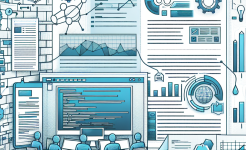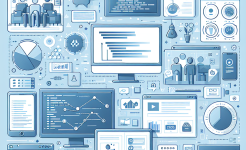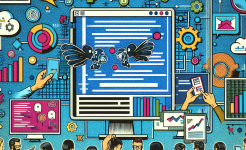In project management, effective communication is the linchpin that holds all aspects of a project together. Two powerful tools that play a crucial role in facilitating communication among project teams, stakeholders, and clients are the Gantt chart and the burndown chart. These visual aids provide a clear and concise representation of project progress, timelines, and resource allocation. By leveraging these charts, project managers can enhance transparency, align expectations, and ensure that everyone involved in the project is on the same page.
The Gantt chart, named after Henry Gantt, is a horizontal bar chart that displays the start and end dates of project tasks, along with their dependencies. It provides a visual overview of the project schedule, allowing project managers to easily identify critical paths, allocate resources, and track progress over time. On the other hand, the burndown chart is a graphical representation of the remaining work in a project over a specific period. It shows the rate at which the work is being completed and helps project teams to forecast whether they will meet their deadlines.
Understanding the Gantt Chart
The Gantt chart is a versatile and widely used tool in project management. It offers a comprehensive view of the project timeline, enabling project managers to plan, schedule, and monitor tasks effectively. One of the key advantages of the Gantt chart is its simplicity. It uses a visual format that is easy to understand, even for those who are not familiar with project management concepts. By representing tasks as bars on a timeline, it provides a clear picture of the start and end dates of each task, as well as their dependencies.
Another important feature of the Gantt chart is its ability to show the critical path of the project. The critical path is the sequence of tasks that determines the shortest possible duration of the project. Any delay in a critical path task will directly impact the project's completion date. By identifying the critical path, project managers can focus their attention on these tasks and allocate resources accordingly to ensure that they are completed on time.
In addition to task scheduling and critical path analysis, the Gantt chart can also be used to track progress. Project managers can update the chart regularly to reflect the actual start and end dates of tasks, as well as any changes in the schedule. This allows stakeholders to stay informed about the project's progress and make informed decisions based on the latest information.
The Power of the Burndown Chart
The burndown chart is a valuable tool for tracking the progress of a project and predicting its completion date. It provides a visual representation of the remaining work in the project over a specific period, typically a sprint or iteration in an agile project. The chart shows the amount of work that was originally planned, the amount of work that has been completed, and the amount of work that remains.
One of the main benefits of the burndown chart is its ability to provide early warning signs of potential problems. If the burndown rate is slower than expected, it indicates that the team may be falling behind schedule. This allows project managers to take corrective action, such as reallocating resources or adjusting the scope of the project, to ensure that the project stays on track.
The burndown chart also helps to foster transparency and accountability within the project team. By making the progress of the project visible to everyone, it encourages team members to take ownership of their tasks and work together to meet the project's goals. It also provides a basis for communication and collaboration between the project team, stakeholders, and clients, as everyone can see the same information and have a shared understanding of the project's status.
Using Gantt and Burndown Charts in Communication

When used together, the Gantt chart and the burndown chart can be powerful communication tools. The Gantt chart provides a high-level overview of the project schedule, while the burndown chart offers a more detailed view of the progress within a specific period. By combining these two charts, project managers can communicate the project's timeline, progress, and potential risks to stakeholders in a clear and concise manner.
For example, during a project status meeting, the project manager can use the Gantt chart to show the overall project schedule and highlight any critical path tasks that are at risk. Then, the burndown chart can be used to provide a more detailed update on the progress of the project within the current sprint or iteration. This allows stakeholders to understand both the big picture and the specific details of the project's progress.
In addition to project status meetings, the Gantt and burndown charts can also be used in other communication channels, such as project reports, dashboards, and online collaboration tools. By making these charts easily accessible to stakeholders, project managers can ensure that everyone has the information they need to make informed decisions and support the project's success.
Challenges and Limitations
While the Gantt chart and the burndown chart are powerful communication tools, they also have some challenges and limitations. One of the main challenges is the complexity of creating and maintaining these charts. In large and complex projects, it can be difficult to accurately define tasks, estimate their durations, and identify their dependencies. This can lead to inaccurate or incomplete charts, which can undermine their effectiveness as communication tools.
Another limitation is that these charts may not be suitable for all types of projects. For example, in highly iterative or agile projects, the traditional Gantt chart may not be able to capture the dynamic nature of the project. Similarly, the burndown chart may not be appropriate for projects with a fixed scope and a long-term schedule.
Finally, the effectiveness of these charts as communication tools depends on the ability of the project team and stakeholders to interpret and understand them. If the charts are not presented in a clear and understandable manner, or if the audience is not familiar with the concepts behind them, they may not be able to effectively communicate the intended information.
Conclusion
In conclusion, the Gantt chart and the burndown chart are valuable tools in project management that play a crucial role in communication. The Gantt chart provides a visual overview of the project schedule, while the burndown chart offers a detailed view of the progress within a specific period. By using these charts together, project managers can enhance transparency, align expectations, and ensure that everyone involved in the project is well-informed.
However, it is important to recognize the challenges and limitations of these charts. Creating and maintaining accurate charts requires careful planning and attention to detail. Additionally, these charts may not be suitable for all types of projects, and their effectiveness depends on the ability of the audience to interpret and understand them.
Despite these challenges, the Gantt chart and the burndown chart remain essential tools in project management. By leveraging their power as communication tools, project managers can improve collaboration, increase accountability, and ultimately drive the success of their projects. As the field of project management continues to evolve, it is likely that these charts will continue to play a vital role in helping project teams to communicate effectively and achieve their goals.
ARTICLE TITLE :Gantt chart and burndown chart: Communication tool in project management ,AUTHOR :ITpmlib

















